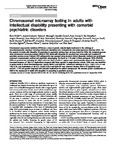Chromosomal microarray testing in adults with intellectual disability presenting with comorbid psychiatric disorders
| dc.contributor.author | Wolfe, K | |
| dc.contributor.author | Strydom, A | |
| dc.contributor.author | Morrogh, D | |
| dc.contributor.author | Carter, J | |
| dc.contributor.author | Cutajar, P | |
| dc.contributor.author | Eyeoyibo, M | |
| dc.contributor.author | Hassiotis, A | |
| dc.contributor.author | McCarthy, J | |
| dc.contributor.author | Mukherjee, R | |
| dc.contributor.author | Paschos, D | |
| dc.contributor.author | Perumal, N | |
| dc.contributor.author | Read, S | |
| dc.contributor.author | Shankar, Rohit | |
| dc.contributor.author | Sharif, S | |
| dc.contributor.author | Thirulokachandran, S | |
| dc.contributor.author | Thygesen, JH | |
| dc.contributor.author | Patch, C | |
| dc.contributor.author | Ogilvie, C | |
| dc.contributor.author | Flinter, F | |
| dc.contributor.author | Bardi, Ugo | |
| dc.contributor.author | Bass, N | |
| dc.date.accessioned | 2021-05-23T10:51:42Z | |
| dc.date.available | 2021-05-23T10:51:42Z | |
| dc.date.issued | 2017-01 | |
| dc.identifier.issn | 1018-4813 | |
| dc.identifier.issn | 1476-5438 | |
| dc.identifier.uri | http://hdl.handle.net/10026.1/17196 | |
| dc.description.abstract |
Chromosomal copy-number variations (CNVs) are a class of genetic variants highly implicated in the aetiology of neurodevelopmental disorders, including intellectual disabilities (ID), schizophrenia and autism spectrum disorders (ASD). Yet the majority of adults with idiopathic ID presenting to psychiatric services have not been tested for CNVs. We undertook genome-wide chromosomal microarray analysis (CMA) of 202 adults with idiopathic ID recruited from community and in-patient ID psychiatry services across England. CNV pathogenicity was assessed using standard clinical diagnostic methods and participants underwent comprehensive medical and psychiatric phenotyping. We found an 11% yield of likely pathogenic CNVs (22/202). CNVs at recurrent loci, including the 15q11-q13 and 16p11.2-p13.11 regions were most frequently observed. We observed an increased frequency of 16p11.2 duplications compared with those reported in single-disorder cohorts. CNVs were also identified in genes known to effect neurodevelopment, namely NRXN1 and GRIN2B. Furthermore deletions at 2q13, 12q21.2-21.31 and 19q13.32, and duplications at 4p16.3, 13q32.3-33.3 and Xq24-25 were observed. Routine CMA in ID psychiatry could uncover ~11% new genetic diagnoses with potential implications for patient management. We advocate greater consideration of CMA in the assessment of adults with idiopathic ID presenting to psychiatry services. | |
| dc.format.extent | 66-72 | |
| dc.format.medium | Print-Electronic | |
| dc.language | en | |
| dc.language.iso | eng | |
| dc.publisher | Springer Science and Business Media LLC | |
| dc.rights | Attribution-NonCommercial-NoDerivatives 4.0 International | |
| dc.rights | Attribution-NonCommercial-NoDerivatives 4.0 International | |
| dc.rights | Attribution-NonCommercial-NoDerivatives 4.0 International | |
| dc.rights | Attribution-NonCommercial-NoDerivatives 4.0 International | |
| dc.rights | Attribution-NonCommercial-NoDerivatives 4.0 International | |
| dc.rights.uri | http://creativecommons.org/licenses/by-nc-nd/4.0/ | |
| dc.rights.uri | http://creativecommons.org/licenses/by-nc-nd/4.0/ | |
| dc.rights.uri | http://creativecommons.org/licenses/by-nc-nd/4.0/ | |
| dc.rights.uri | http://creativecommons.org/licenses/by-nc-nd/4.0/ | |
| dc.rights.uri | http://creativecommons.org/licenses/by-nc-nd/4.0/ | |
| dc.subject | Adolescent | |
| dc.subject | Adult | |
| dc.subject | Aged | |
| dc.subject | Autism Spectrum Disorder | |
| dc.subject | Calcium-Binding Proteins | |
| dc.subject | Cell Adhesion Molecules, Neuronal | |
| dc.subject | Chromosome Aberrations | |
| dc.subject | Chromosomes, Human, Pair 15 | |
| dc.subject | Chromosomes, Human, Pair 16 | |
| dc.subject | Comparative Genomic Hybridization | |
| dc.subject | DNA Copy Number Variations | |
| dc.subject | England | |
| dc.subject | Female | |
| dc.subject | Humans | |
| dc.subject | Intellectual Disability | |
| dc.subject | Male | |
| dc.subject | Microarray Analysis | |
| dc.subject | Middle Aged | |
| dc.subject | Nerve Tissue Proteins | |
| dc.subject | Neural Cell Adhesion Molecules | |
| dc.subject | Receptors, N-Methyl-D-Aspartate | |
| dc.subject | Schizophrenia | |
| dc.subject | White People | |
| dc.title | Chromosomal microarray testing in adults with intellectual disability presenting with comorbid psychiatric disorders | |
| dc.type | journal-article | |
| dc.type | Journal Article | |
| plymouth.author-url | https://www.webofscience.com/api/gateway?GWVersion=2&SrcApp=PARTNER_APP&SrcAuth=LinksAMR&KeyUT=WOS:000394116100012&DestLinkType=FullRecord&DestApp=ALL_WOS&UsrCustomerID=11bb513d99f797142bcfeffcc58ea008 | |
| plymouth.issue | 1 | |
| plymouth.volume | 25 | |
| plymouth.publication-status | Published | |
| plymouth.journal | European Journal of Human Genetics | |
| dc.identifier.doi | 10.1038/ejhg.2016.107 | |
| plymouth.organisational-group | /Plymouth | |
| plymouth.organisational-group | /Plymouth/Faculty of Health | |
| plymouth.organisational-group | /Plymouth/Users by role | |
| dc.publisher.place | England | |
| dcterms.dateAccepted | 2016-06-28 | |
| dc.identifier.eissn | 1476-5438 | |
| dc.rights.embargoperiod | Not known | |
| rioxxterms.versionofrecord | 10.1038/ejhg.2016.107 | |
| rioxxterms.licenseref.uri | http://creativecommons.org/licenses/by-nc-nd/4.0/ | |
| rioxxterms.licenseref.startdate | 2016-01 | |
| rioxxterms.type | Journal Article/Review |



